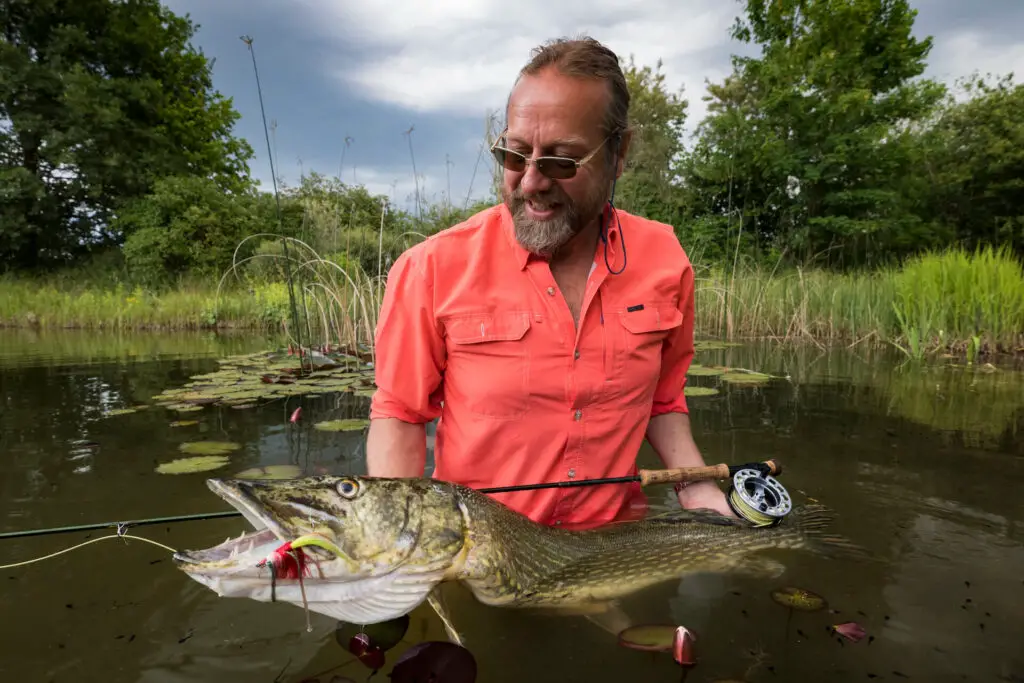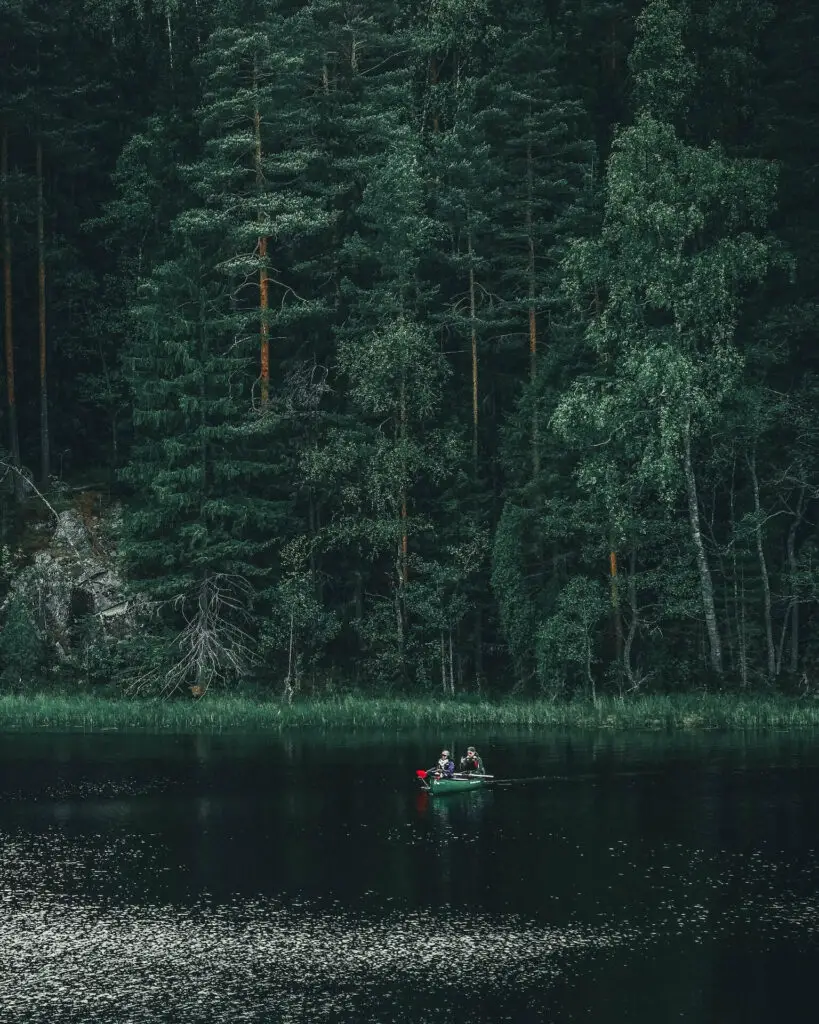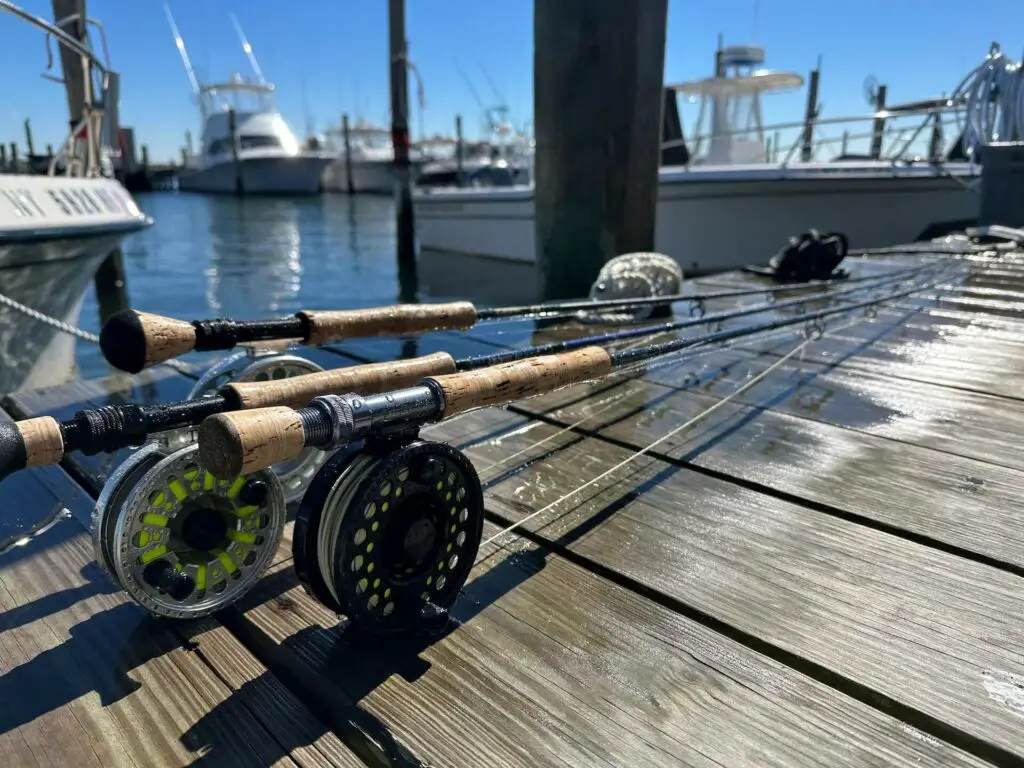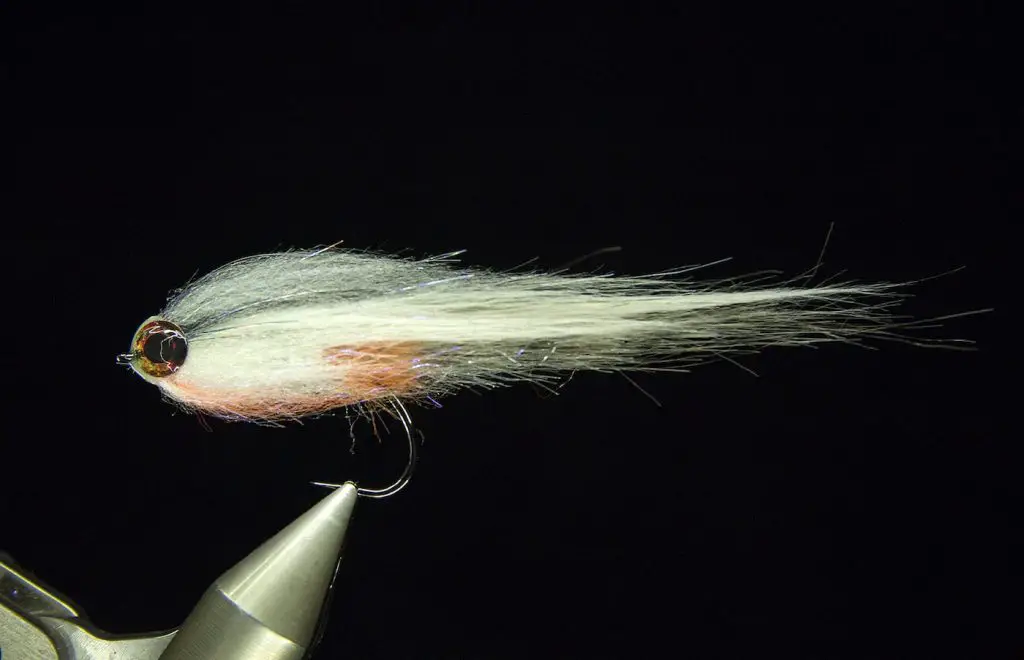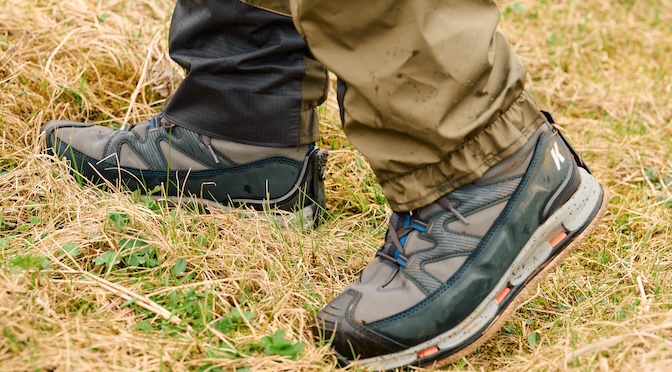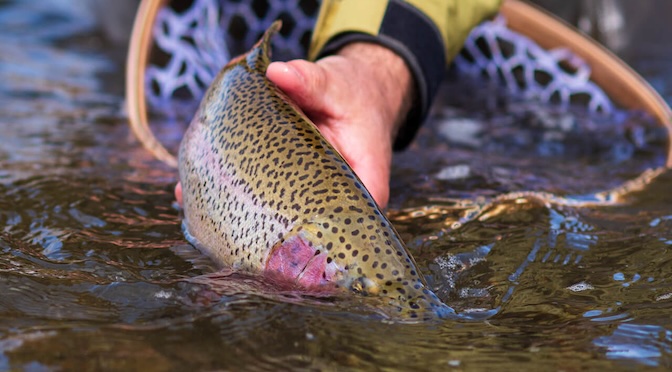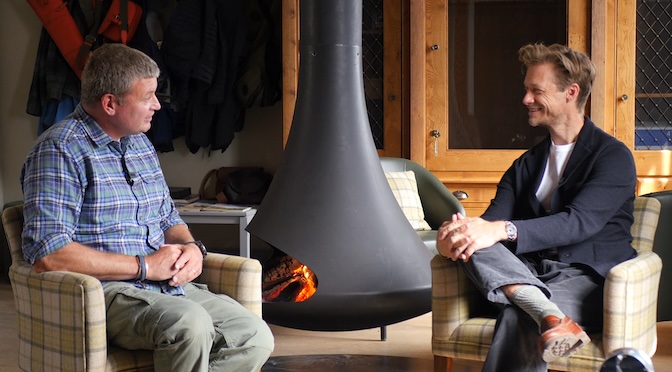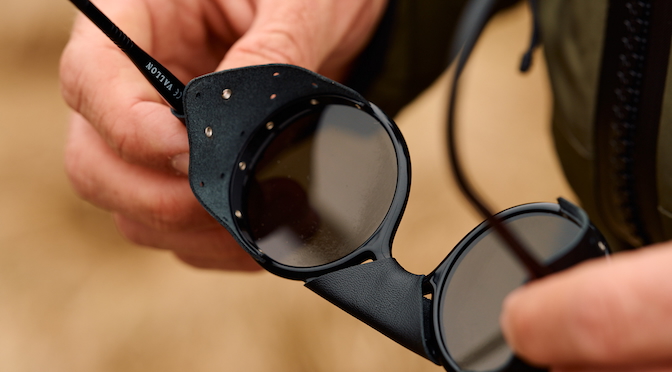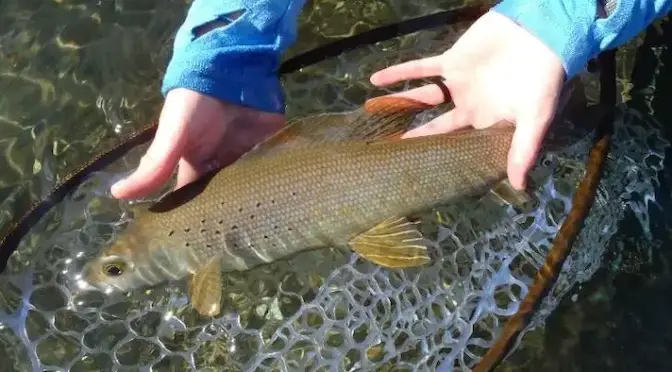Last updated on May 26th, 2023.
- Wading Wisdom #13 – Simon Gawesworth - July 7, 2025
- On the Water with the Korkers Bantam Lite - June 26, 2025
- How to Find Trout in Rivers & Streams Anywhere - June 13, 2025
Fly fishing for pike is an exciting and rewarding experience that can be enjoyed by any angler.
Whether you’re a beginner or an experienced fly fisherman, pursuing these fish on the end of your line offers many unique challenges and opportunities to land some trophy-sized specimens. Pike are found in various types of water from lakes to rivers, making them accessible all over the world. Knowing what gear to use, techniques for successful pike fly fishing and where they live makes this sport even more enjoyable. In this article we’ll explore why pike are so sought after as well as tips and tricks for success when targeting these aggressive predators with a fly rod.
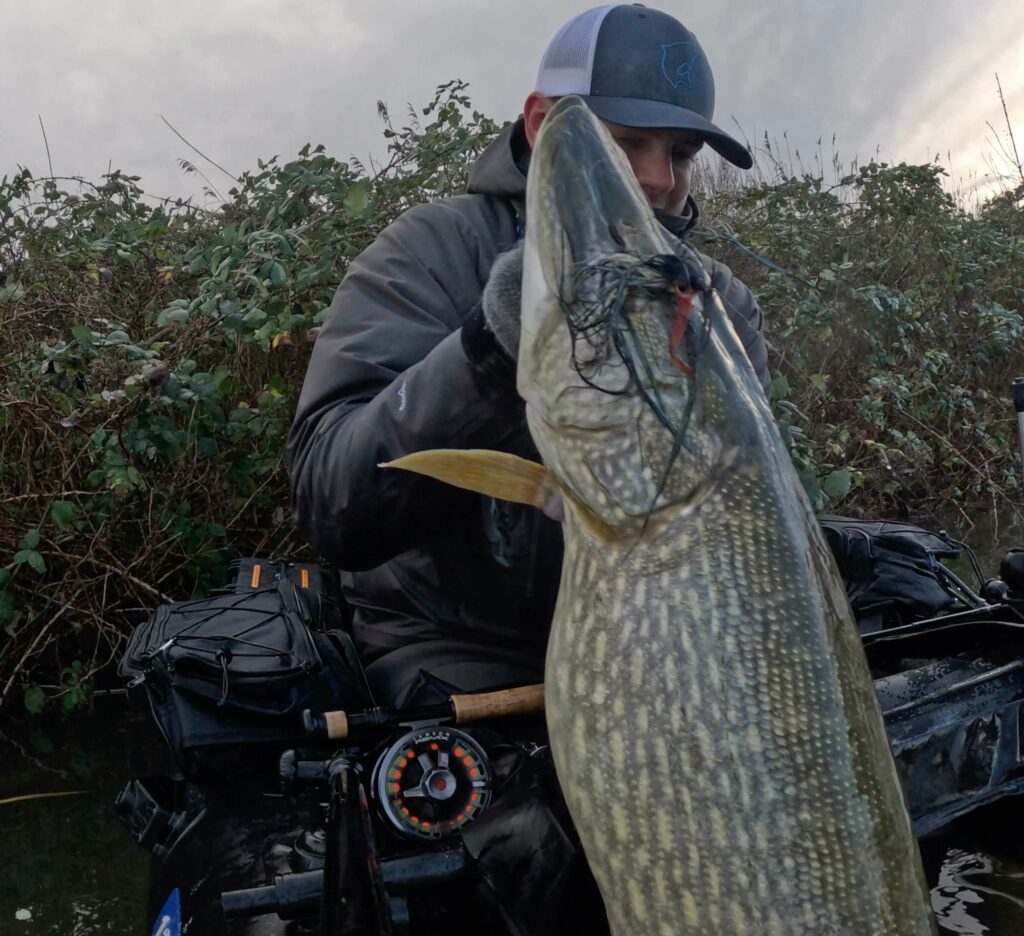
Table of Contents:
Why Pike are a Sought After Species for Fly Fishing
What Gear to Use for Pike Fly Fishing
Techniques for Pike Fly Fishing
Tips for Successful Pike Fly Fishing
Why Pike are a Sought After Species for Fly Fishing
Their powerful bulk and keen teeth make them a formidable opponent to battle against when on the line. Their razor sharp teeth, muscular bodies, and lightning fast strikes make them a thrilling catch for any angler.
Their Aggressive Nature
Pike are known for their voracious appetite and willingness to take flies or lures from unsuspecting fishermen. This makes them one of the most exciting fish to target with a fly rod as they will often hit hard when presented with the right offering. They can be found in rivers, streams, lakes, ponds, estuaries and bays where they hunt smaller prey such as minnows or frogs.
The Challenge of Catching Them
Pike can be difficult to land due to their size and strength but also because they tend to stay close to cover like logs or weeds which makes it harder for you to get your line back once you’ve hooked one. You need quick reflexes when fighting these fish so having good technique is essential if you want success on the water. It’s also important that you use appropriate tackle such as heavy duty rods and reels with strong leaders in order not lose out on what could potentially be your biggest catch ever.
These fish can grow up into very large sizes depending on where they live; some specimens have been recorded at over 50 pounds. As well as being big in size, pike are incredibly powerful fighters that require special techniques when targeting them with a fly rod. This is why many experienced anglers prefer using heavier gear than usual when trying their luck against these monsters from beneath the surface.
Fly fishing for pike is an exciting and challenging pursuit, with their aggressive nature, size, and strength making them a sought-after species. Uncovering the whereabouts of pike can be a perplexing, random task; they inhabit various environments – from rivers and creeks to inlets and bays.
Key Takeaway: Fly fishing pike can be an exciting challenge due to their size, strength and aggressive nature, requiring special techniques and heavier tackle than usual.
Where to Find Pike
Fly fishing for pike requires knowledge of their habitat; they may inhabit rivers, lakes, ponds, estuaries and bays. Pike can be located in a number of aquatic habitats, ranging from rivers and creeks to lakes and ponds, as well as coastal areas. Each environment offers its own unique challenges when targeting these aggressive predators.
Rivers and Streams
Rivers are often the best place to start looking for pike due to their abundance of food sources like minnows, frogs, crayfish, insects and more. The fast-moving current also provides plenty of oxygen which helps keep the fish active throughout the day. Look for areas with deeper pools or eddies that provide shelter from the current – this is where you’ll likely find your target species lurking about.
Lakes and Ponds
Lakes are great places to look for pike because they tend to have larger populations than rivers or streams do. You’ll want to focus on weedy areas near shorelines since this is where most of their prey will congregate during warmer months. During colder weather months you may need to venture out into deeper waters if you want any chance at catching one of these beasts.
Estuaries provide an ideal habitat for many species, including pike. The brackish environment is a combination of fresh water from rivers flowing into saltwater from nearby oceans or seas, making it the perfect place to find prey such as baitfish in shallow waters near shorelines and drop offs leading to deeper depths further offshore. Pike are attracted to these areas due to their abundance of food sources and can often be found lurking around looking for their next meal.
Once you’ve identified the areas where pike can be found, it’s time to select the right gear for fly fishing – rods and reels, leaders and flies.
Key Takeaway: Fly fishing for pike can be a rewarding activity when the right spots are found, like rivers and streams, lakes or ponds with plentiful food sources, or estuaries.
What Gear to Use for Pike Fly Fishing
Rods and Reels for Pike Fly Fishing
When it comes to pike fly fishing, having the right gear is essential for success. The size of the fish and type of water they inhabit should be taken into consideration when selecting rods and reels. Pike are known for their aggressive nature, so a rod that can handle their strength is necessary. A medium-heavy action rod with a fast taper is ideal for pike fishing in rivers or streams. For lakes and ponds, a heavier action rod may be needed due to the larger size of these fish. Reels should also have an adequate drag system as well as plenty of line capacity in order to land large pikes successfully.
Pike Fly Fishing Leaders
Leaders and flies are also important components when targeting pike with a fly rod. Pike fly fishing leaders should be made hard mono or wire since their teeth are so sharp that they will easily cut even heavy monofilament or fluorocarbon material. Flies should imitate baitfish such as minnows, shad, sculpins, leeches, etc., depending on what type of food source the local population prefers at any given time throughout the year. Streamer patterns work best during early spring months while smaller nymphs become more effective later in summer and fall seasons when insect hatches occur naturally along riverbanks or lake shores where these predators feed heavily on them during those times of year.
Having the right gear for pike fly fishing is essential to having a successful outing, so make sure you have all of the necessary equipment before setting out. Now that you know what gear to use, it’s time to learn about techniques for pike fly fishing.
Key Takeaway: Pike fly fishing requires specialized gear and flies that imitate baitfish to effectively target this aggressive species, which can be found in both rivers and lakes throughout North America.
Techniques for Pike Fly Fishing
To successfully target pike with a fly rod, it’s important to understand the various techniques that can be used.
The Fast Retrieve Methodology is one of the most popular techniques when targeting pike with a fly rod. This technique involves casting out your line and then quickly retrieving it in short, jerky motions. The idea behind this method is to mimic an injured baitfish or insect which will attract hungry pike looking for an easy meal. When using this technique, make sure you use flies that imitate small fish or insects as they will be more likely to draw attention from nearby predators like pike.
The Slow Retrieve Methodology is another effective technique when targeting pike with a fly rod. This method requires anglers to cast out their line and slowly retrieve it back in long steady pulls while keeping contact with the bottom of the water body being fished. The slow retrieval allows any potential prey items such as minnows or crayfish time to react before being engulfed by an opportunistic predator like a northern pike lurking below waiting for its next meal.
Once you’ve mastered the various techniques for pike fly fishing, it’s time to apply your newfound knowledge by utilizing tips and strategies designed to maximize success.
Key Takeaway: Fly fishing for pike requires the use of different techniques, such as fast and slow retrieves, to imitate injured prey and attract these aggressive predators.
Tips for Successful Pike Fly Fishing
Location Selection Strategies
Pike are typically found in shallow, weedy areas of lakes and ponds or slow-moving sections of rivers and streams. Look for areas with plenty of cover such as fallen trees, submerged logs, weed beds, rocks or other structure that provides shelter for the fish. In addition to these physical features, pay attention to the water temperature; pike prefer cooler waters so look for spots where there is a drop off in temperature.
Presentation Tactics
Once you’ve located an area with potential pike activity, it’s time to present your flies effectively. The most common technique used when targeting pike on a fly rod is casting along the edges of weeds and other structures while using fast retrieves interspersed with pauses. This allows your flies to sink down into the strike zone before being quickly retrieved back out again which can often trigger strikes from aggressive predators like pike. Another effective tactic is blind casting over deeper waters; this method works best when combined with large streamers that imitate baitfish or crayfish patterns which are popular food sources for larger pike species.
Key Takeaway: Fly fishing for pike requires careful location selection and presentation tactics, such as casting along the edges of weeds and other structures with fast retrieves interspersed with pauses, or blind casting over deeper waters using large streamers that imitate baitfish or crayfish.
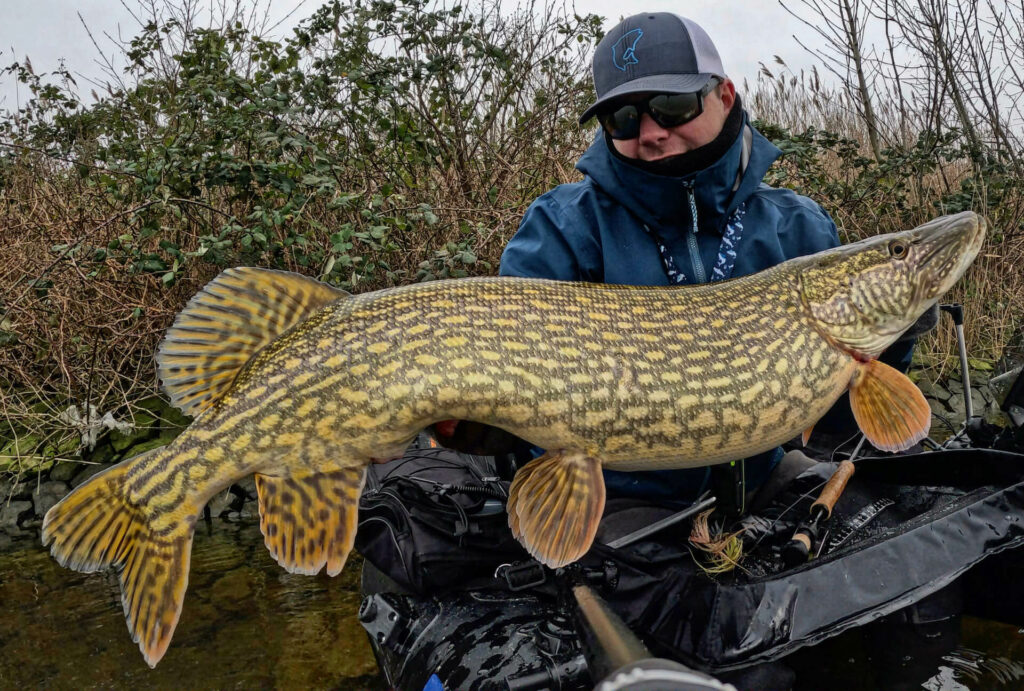
Conclusion
Outfitted with the necessary equipment, techniques and information on where to locate them, you can have a fruitful outing. Whether you’re looking for a fast-paced fight or a slow and steady battle with one of these powerful predators, fly fishing for pike is sure to provide an unforgettable experience. So grab your rod and reel, tie on some flies, and get out there – it’s time to go pike fly fishing.
Fly fishing pike is an exciting and rewarding experience that can be enjoyed by anglers of all levels. Unfortunately, the number of pike in many waters has been declining due to pollution and other environmental factors. To ensure these species remain abundant we must work together as a community to protect their habitats and promote sustainable practices such as catch-and-release fishing methods. With your help, we can continue to enjoy pike fly fishing into the future!
FAQs in Relation to Fly Fishing for Pike
What size fly rod for pike?
A 9-10 foot long, 8-9 weight fly rod is ideal for this purpose. The extra length and power of the longer rod helps to cast larger flies farther with more accuracy while the heavier line rating provides enough backbone to handle big fish. Additionally, the increased randomness provided by a longer rod gives you better control over your casts in windy conditions or when targeting structure such as weed beds and logs.
What type of fly line for pike?
When fishing for pike, the kind of line you pick can be significant. For maximum success, an intermediate or sinking line is recommended. This will allow your flies to sink deeper and stay in the strike zone longer. A weight-forward floating line is also suitable if you’re looking for more accuracy when casting. Make sure that whatever line you choose has enough strength and abrasion resistance to handle these powerful fish. With the right line, you’ll be sure to have a successful and enjoyable fly fishing experience.
What is the best rig for pike fishing?
Pike fishing requires a specialized rig to ensure success. The best setup for pike is a 9-foot rod with a medium-fast action, paired with an 8-weight floating line and a sinking leader of at least 10 feet in length. A wire trace should be used when targeting larger pike as they have sharp teeth that can easily cut through monofilament lines. Lastly, the use of large streamers or poppers will help attract these aggressive predators and increase your chances of landing one.
What weight fly rod for pike and musky?
When it comes to fly fishing for pike and musky, the ideal rod weight depends on a variety of factors. Generally speaking, rods in the 8-10wt range are best suited for these species. This is because they provide enough power to cast large flies and fight larger fish while still having enough finesse to present smaller offerings with accuracy. Additionally, heavier rods can help absorb shock when setting the hook or playing a fish which can be especially important when targeting these powerful species. Ultimately, selecting the ideal rod weight is contingent on one’s individual proclivities as well as regional parameters; thus, it’s best to consult a knowledgeable instructor or fisher prior to acquiring.

